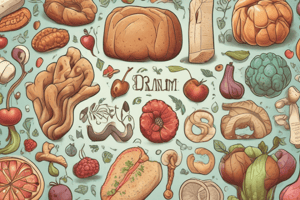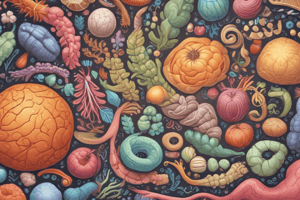Podcast
Questions and Answers
What are monosaccharides primarily known for?
What are monosaccharides primarily known for?
- Being composed of two sugar units
- Serving as a quick energy source (correct)
- Being insoluble in water
- Consisting of multiple sugar units
Which of the following is NOT considered a type of carbohydrate?
Which of the following is NOT considered a type of carbohydrate?
- Disaccharides
- Triglycerides (correct)
- Oligosaccharides
- Polysaccharides
What distinguishes polysaccharides from other types of carbohydrates?
What distinguishes polysaccharides from other types of carbohydrates?
- They are typically sweet in taste
- They are made up of only two sugar units
- They are made up of more than two sugar units (correct)
- They are a source of protein
Which carbohydrate is a complex carbohydrate primarily used for energy storage in animals?
Which carbohydrate is a complex carbohydrate primarily used for energy storage in animals?
Which type of carbohydrate is digested quickly and provides quick energy?
Which type of carbohydrate is digested quickly and provides quick energy?
What is the primary characteristic of soluble fibre?
What is the primary characteristic of soluble fibre?
What distinguishes functional fibre from dietary fibre?
What distinguishes functional fibre from dietary fibre?
Which food is a source of insoluble fibre?
Which food is a source of insoluble fibre?
What is the role of soluble fibre in the digestive system?
What is the role of soluble fibre in the digestive system?
Which of the following correctly defines total fibre?
Which of the following correctly defines total fibre?
Which of the following correctly defines oligosaccharides?
Which of the following correctly defines oligosaccharides?
What is the primary function of glycogen in humans?
What is the primary function of glycogen in humans?
Which statement about starch is false?
Which statement about starch is false?
What type of linkages are present in amylose?
What type of linkages are present in amylose?
What major characteristic of glycogen allows it to release energy quickly?
What major characteristic of glycogen allows it to release energy quickly?
What differentiates soluble fiber from insoluble fiber?
What differentiates soluble fiber from insoluble fiber?
What is the range of chains in glycogen's structure?
What is the range of chains in glycogen's structure?
Which of the following polysaccharides is known for being a significant energy source for the body?
Which of the following polysaccharides is known for being a significant energy source for the body?
What is gluconeogenesis?
What is gluconeogenesis?
What happens to body proteins when glycogen stores are depleted?
What happens to body proteins when glycogen stores are depleted?
How much carbohydrate is needed daily to support bodily functions?
How much carbohydrate is needed daily to support bodily functions?
What is the 'protein sparing action' of carbohydrates?
What is the 'protein sparing action' of carbohydrates?
What leads to ketosis in the body?
What leads to ketosis in the body?
Which hormone is secreted by the pancreas in response to high blood glucose levels?
Which hormone is secreted by the pancreas in response to high blood glucose levels?
What is the glycemic index?
What is the glycemic index?
What condition results from insufficient insulin production or decreased cell sensitivity to insulin?
What condition results from insufficient insulin production or decreased cell sensitivity to insulin?
Which type of diet has been associated with an increased risk of heart disease?
Which type of diet has been associated with an increased risk of heart disease?
What is the effect of high fibre diets on bowel disorders?
What is the effect of high fibre diets on bowel disorders?
What type of carbohydrates can lead to high serum triglyceride levels?
What type of carbohydrates can lead to high serum triglyceride levels?
What is a potential benefit of viscous fibres in the diet?
What is a potential benefit of viscous fibres in the diet?
Which statement about dietary fibre and cancer risk is true?
Which statement about dietary fibre and cancer risk is true?
What is a primary characteristic of soluble fibre?
What is a primary characteristic of soluble fibre?
What is the unclear influence of dietary fibre mentioned in studies?
What is the unclear influence of dietary fibre mentioned in studies?
What are short-chain fatty acids (SCFA) produced from?
What are short-chain fatty acids (SCFA) produced from?
Flashcards are hidden until you start studying
Study Notes
Carbohydrate Types
- Complex carbohydrates are oligosaccharides (3-10 monosaccharides) and polysaccharides (> 10 monosaccharides)
- They are straight or branched chains of monosaccharides joined by condensation reactions.
- Examples: starch, glycogen.
Starch
- Amylose is a continuous single chain of glucose molecules joined by alpha (1-4) links.
- Amylopectin is a branched chain of glucose molecules joined by alpha (1-4) links with branches connected by alpha (1-6) links.
- Different types of amylose and amylopectin contribute to different characteristics (flavor, solubility, thickening power) in food science.
- From a nutritional perspective, starches are all the same and broken down to glucose.
Glycogen
- The storage form of carbohydrates (energy) in humans and animals.
- Highly branched chains of glucose (10-18 chains).
- High branching allows glycogen to bind with water (limited water storage).
- Fast hydrolysis allows for a quick energy supply.
- The body stores glycogen for approximately 12-18 hours.
Carbohydrate Structure - Simple and Complex
- Monosaccharides are made up of 1 sugar unit (single sugars).
- Disaccharides are made up of 2 sugar units (double sugars).
- Polysaccharides are made up of more than 2 sugar units.
- Simple carbohydrates provide a quick energy source and are digested quickly.
- Complex carbohydrates are digested slowly and provide a sustained release of energy.
Fibre
- Total fibre is made up of dietary fibre and functional fibre.
- Dietary fibre is edible, non-digestible and derived from plants.
- Functional fibre is isolated, extracted, and added to food or pills for health benefits.
- Fibre can be described by its solubility and digestibility:
- Solubility: the extent to which a substance can be dissolved in water.
- Digestibility: the extent to which a substance can be broken down in the digestive system.
Types of Fibre
- Soluble (Viscous) fibre:
- Dissolves and swells in water, forming a gel.
- Slows down digestion, delaying gastric emptying.
- Helps to lower cholesterol levels.
- Insoluble (non-viscous) fibre:
- Does not dissolve in water.
- Provides roughage and bulk, helping to keep you regular.
- Helps to prevent constipation.
Examples of Soluble and Insoluble Fibre
- Soluble Fibre: Fruits (pectins), legumes, oats, flaxseed, barley, rye, guar gum, acacia gum, carrageenan, psyllium, some hemicelluloses.
- Insoluble Fibre: Skins of fruits and vegetables, broccoli, celery, blackberries, raspberries, whole wheat pasta, brown rice, nuts and seeds.
Gluconeogenesis
- The body produces glucose from various 3C substrates including protein and pyruvate.
- Gluconeogenesis is the process of making glucose from non-carbohydrate sources (gluco = glucose; neo = new; genesis = making).
Problems with Insufficient Dietary Carbohydrate
- Ketosis: inefficient breakdown of fatty acids.
- Protein breakdown to produce glucose: occurs during starvation or insufficient dietary carbohydrate.
- Adults need a minimum of 100 g/day of carbohydrates to supply sufficient glucose for bodily functions.
Insufficient Glucose in the Body: Protein Breakdown
- When there is insufficient carbohydrate, the body depletes muscle glycogen stores.
- When glycogen stores are depleted, the body breaks down body protein to produce glucose.
- This protein breakdown can lead to problems with growth, maintenance, nutrient transport, hormone production, and immune system regulation.
The Protein-Sparing Action of Carbohydrates
- Diets providing enough carbohydrate "spare" protein, meaning they preserve the body's use of protein for its intended and essential functions.
Blood Glucose Regulation
- Diabetes mellitus: disease caused by either insufficient insulin production or decreased sensitivity of cells to insulin, leading to elevated blood glucose levels.
- Hypoglycemia: Low blood glucose levels, usually below 2.2 to 2.8 mmol/L.
- Blood-glucose response curve: shows changes in blood glucose levels after consuming food.
Hormones Involved in Blood Glucose Regulation
- Insulin: secreted by the pancreas in response to a rise in blood glucose levels.
- Glucagon: secreted by the pancreas in response to a decline in blood glucose levels.
Glycemic Response and Glycemic Index
- Glycemic response: How quickly and how high blood glucose rises after carbohydrates are consumed.
- Glycemic index: ranks foods based on their impact on the glycemic response.
Carbohydrates and Heart Disease
- Diets high in sugar or refined carbohydrates raise blood lipid levels (triglycerides), increasing the risk of heart disease.
- Diets high in whole grains can reduce the risk of heart disease.
- High-carbohydrate diets can increase levels of triglycerides and high-density lipoproteins (HDL) cholesterol.
- High serum triglycerides are higher when the primary carbohydrate in the diet is monosaccharides (simple sugars), especially fructose.
- Soluble fibre can bind to dietary cholesterol in the gut and be excreted via waste.
Indigestible Carbohydrates and Bowel Disorders
- Diets high in fibre or indigestible carbohydrates can relieve or prevent certain bowel disorders: hemorrhoids, diverticulosis, diverticulitis, and constipation.
- Epidemiological studies show lower incidence of colon cancer in populations with high-fibre diets.
- More research is needed on the effects of fibre supplements and the relationship between fibre intake and certain cancers.
Indigestible Carbohydrates and Other Conditions
- Viscous fibre can increase insulin tissue response and protect against diabetes.
- The influence of dietary fibre on obesity is unclear.
- Some fibre is fermented by gut bacteria, producing short-chain fatty acids (SCFA) which cannot be absorbed.
- Some fibre lowers blood cholesterol levels.
Studying That Suits You
Use AI to generate personalized quizzes and flashcards to suit your learning preferences.




